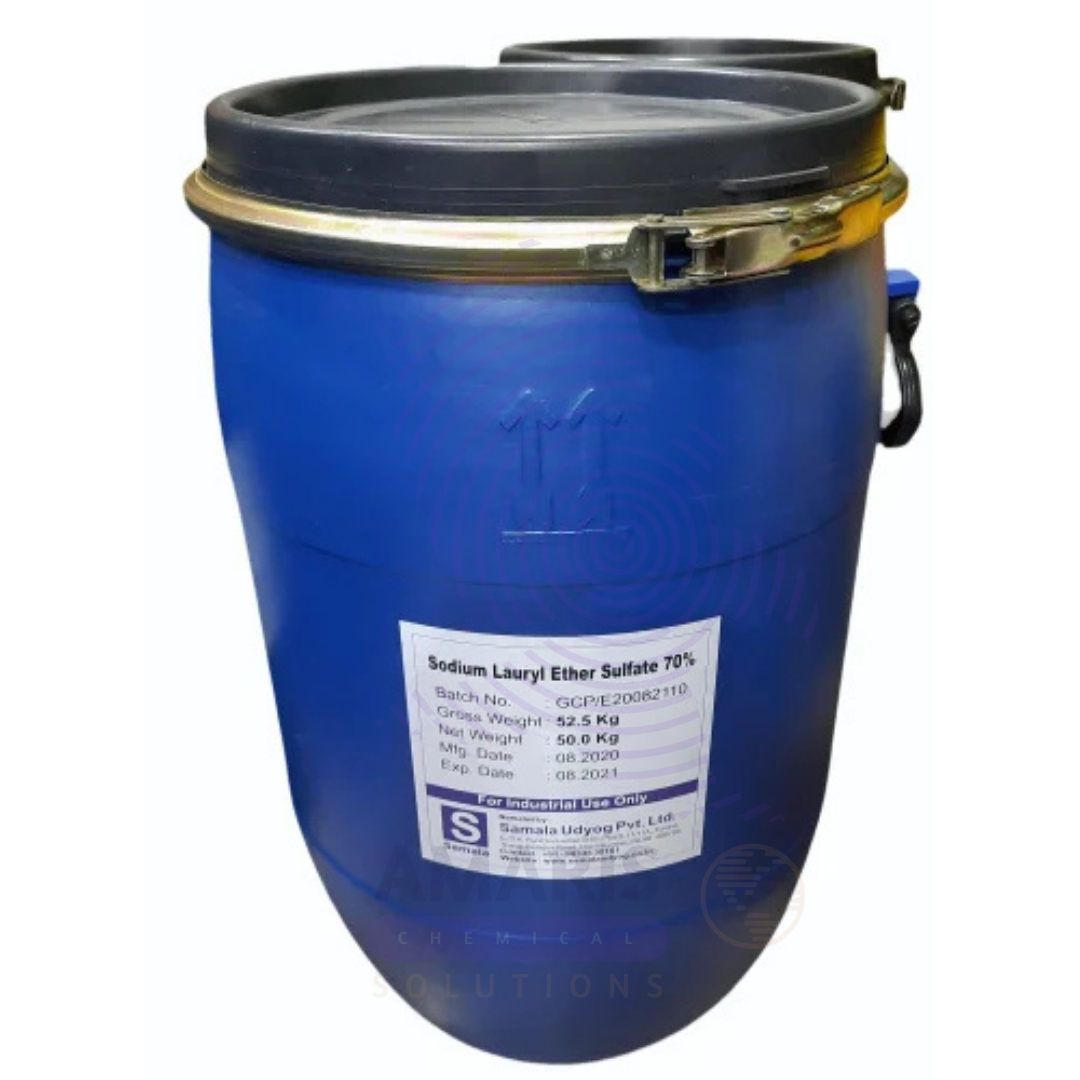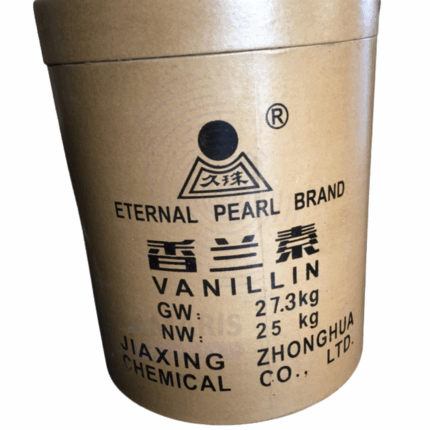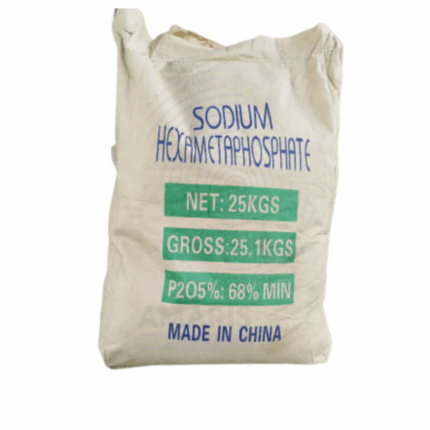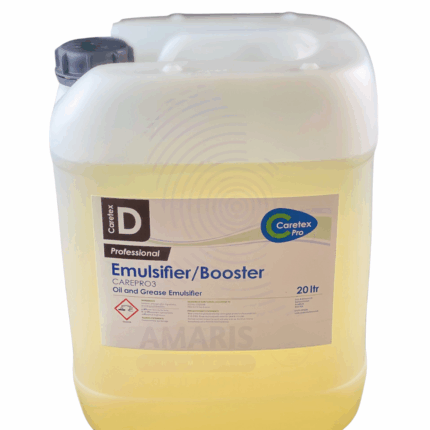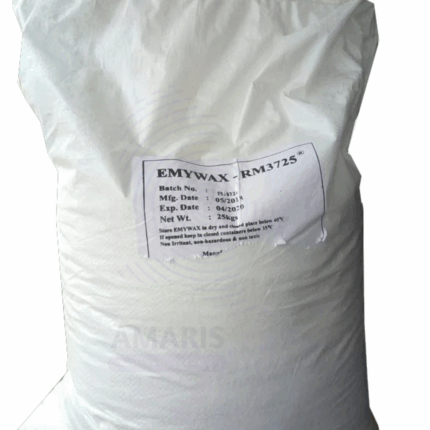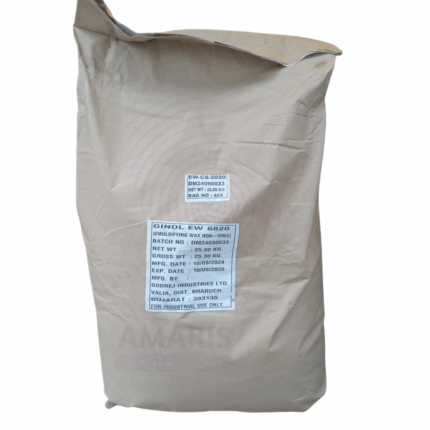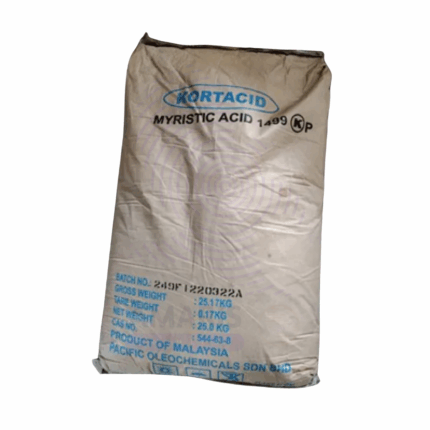Sodium Lauryl Ether Sulphate
$ 2.90 Original price was: $ 2.90.$ 2.82Current price is: $ 2.82.
Sodium Lauryl Ether Sulphate (SLES) is a versatile anionic surfactant commonly used in personal care, household, and industrial cleaning products. It is a clear to slightly yellow viscous liquid or powder derived from ethoxylated lauryl alcohol and sulfuric acid, neutralized with sodium hydroxide. SLES is valued for its excellent foaming, cleansing, and emulsifying properties. It is biodegradable and widely accepted for use in cosmetic and cleaning formulations, providing mildness and effective removal of dirt and oils.
Sodium Lauryl Ether Sulphate
Primary Uses
- Personal Care Industry
- Used as a primary surfactant in shampoos, body washes, liquid soaps, and facial cleansers due to its excellent foaming and cleansing ability.
- Functions as a detergent and emulsifier in toothpaste and bubble baths.
- Acts as a wetting agent in shaving creams and other skincare products.
- Household Cleaning Products
- Key ingredient in dishwashing liquids, laundry detergents, and surface cleaners for effective grease and soil removal.
- Provides foaming and emulsification in hard surface cleaners and car shampoos.
- Industrial Applications
- Used in textile processing, metal cleaning, and as a component in industrial degreasers.
- Employed in oilfield chemicals as a foaming agent.
- Agricultural Products
- Functions as an emulsifier and wetting agent in pesticide and herbicide formulations.
Secondary Uses
- Pharmaceuticals
- Incorporated in topical pharmaceutical creams and gels as a surfactant and emulsifier.
- Cosmetics
- Used in formulations of facial masks, scrubs, and bath salts for texture and cleansing enhancement.
- Food Industry
- Occasionally used in non-food-contact applications requiring surfactants, but not for direct food contact.
Basic Identification Attributes
- Chemical Name (IUPAC): Sodium laureth sulfate
- Common/Trade Name: Sodium Lauryl Ether Sulphate, SLES
- CAS Number: 9004-82-4
- HS Code: 3402.11
- Synonyms: Sodium lauryl ether sulfate, Sodium laureth sulfate, SLES
Physical & Chemical Properties
- Physical State: Viscous liquid or powder (depending on formulation)
- Color & Odor: Clear to pale yellow; mild characteristic odor
- pH: Typically 7-9 (1% solution)
- Density: Approximately 1.01-1.03 g/cm³ (liquid form)
- Solubility: Fully soluble in water; insoluble in oils and hydrocarbons
Safety & Hazard Attributes
- GHS Classification: Eye irritant, skin irritant at high concentrations
- Toxicity: Low toxicity; mild irritant to eyes and skin on prolonged contact
- Exposure Limits: Follow occupational safety guidelines for surfactants
Storage & Handling Attributes
- Storage Conditions: Store in a cool, dry place away from direct sunlight and strong oxidizers
- Container Type: Supplied in plastic drums, totes, or bulk containers
- Shelf Life: Typically 12-24 months under proper storage
- Handling Precautions: Use protective gloves and goggles; avoid inhalation of aerosols or dust
- Storage Measures: Keep containers tightly closed and stored in a dry environment
Regulatory & Compliance Attributes
- Complies with cosmetic and personal care ingredient regulations (e.g., EU Cosmetic Regulation, FDA)
- Listed as safe for use in rinse-off cosmetic products by CIR (Cosmetic Ingredient Review)
- Meets REACH and GHS regulatory standards
Environmental & Health Impact
- Biodegradability: Readily biodegradable under aerobic conditions
- Ecotoxicity: Low toxicity to aquatic organisms at typical use concentrations
- Bioaccumulation: Not expected to bioaccumulate
Safety Handling Precautions
- PPE Required: Gloves, eye protection, protective clothing recommended
- Handling Guidelines: Avoid contact with eyes and prolonged skin exposure
- Storage Measures: Store separately from strong acids and oxidizers
First Aid Measures
- Inhalation: Move to fresh air; seek medical attention if irritation occurs
- Skin Contact: Wash affected area with soap and water; seek medical advice if irritation persists
- Eye Contact: Rinse eyes thoroughly with water for 15 minutes; seek immediate medical care if irritation persists
- Ingestion: Rinse mouth; do not induce vomiting; seek medical attention if large amounts ingested
Firefighting Measures
- Fire Hazards: Non-flammable
- Extinguishing Media: Use water spray, foam, dry chemical, or CO₂ extinguisher
- Special Precautions: Avoid breathing fumes from heated material
- Hazardous Combustion Products: Carbon oxides, sulfur oxides


 Preservatives(food)
Preservatives(food) Flavor Enhancers
Flavor Enhancers Acidulants
Acidulants Sweeteners
Sweeteners Antioxidants
Antioxidants Colorants(food)
Colorants(food) Nutraceutical Ingredients (food)
Nutraceutical Ingredients (food) Nutrient Supplements
Nutrient Supplements Emulsifiers
Emulsifiers
 Collectors
Collectors Dust Suppressants
Dust Suppressants Explosives and Blasting Agents
Explosives and Blasting Agents Flocculants and Coagulants
Flocculants and Coagulants Frothers
Frothers Leaching Agents
Leaching Agents pH Modifiers
pH Modifiers Precious Metal Extraction Agents
Precious Metal Extraction Agents
 Antioxidants(plastic)
Antioxidants(plastic) Colorants (Pigments, Dyes)
Colorants (Pigments, Dyes) Fillers and Reinforcements
Fillers and Reinforcements Flame Retardants
Flame Retardants Monomers
Monomers Plasticizers
Plasticizers Polymerization Initiators
Polymerization Initiators Stabilizers (UV, Heat)
Stabilizers (UV, Heat)
 Antifoaming Agents
Antifoaming Agents Chelating Agents
Chelating Agents Coagulants and Flocculants
Coagulants and Flocculants Corrosion Inhibitors
Corrosion Inhibitors Disinfectants and Biocides
Disinfectants and Biocides Oxidizing Agents
Oxidizing Agents pH Adjusters
pH Adjusters Scale Inhibitors( water)
Scale Inhibitors( water)
 Antioxidants(cosmetic)
Antioxidants(cosmetic) Emollients
Emollients Fragrances and Essential Oils
Fragrances and Essential Oils Humectants
Humectants Preservatives
Preservatives Surfactants(cosmetic)
Surfactants(cosmetic) Thickeners
Thickeners UV Filters
UV Filters
 Fertilizers
Fertilizers Soil Conditioners
Soil Conditioners Plant Growth Regulators
Plant Growth Regulators Animal Feed Additives
Animal Feed Additives Biostimulants
Biostimulants Pesticides (Herbicides, Insecticides, Fungicides)
Pesticides (Herbicides, Insecticides, Fungicides)
 Active Pharmaceutical Ingredients (APIs)
Active Pharmaceutical Ingredients (APIs) Excipients
Excipients Solvents(pharmaceutical)
Solvents(pharmaceutical) Antibiotics
Antibiotics Antiseptics and Disinfectants
Antiseptics and Disinfectants Vaccine Adjuvants
Vaccine Adjuvants Nutraceutical Ingredients (pharmaceutical)
Nutraceutical Ingredients (pharmaceutical) Analgesics & Antipyretics
Analgesics & Antipyretics
 Analytical Reagents
Analytical Reagents Solvents(lab)
Solvents(lab) Chromatography Chemicals
Chromatography Chemicals Spectroscopy Reagents
Spectroscopy Reagents microbiology-and-cell-culture-reagents
microbiology-and-cell-culture-reagents Molecular Biology Reagents
Molecular Biology Reagents Biochemical Reagents
Biochemical Reagents Inorganic and Organic Standards
Inorganic and Organic Standards Laboratory Safety Chemicals
Laboratory Safety Chemicals Specialty Laboratory Chemicals(Special Laboratory Equipment)
Specialty Laboratory Chemicals(Special Laboratory Equipment)
 Demulsifiers
Demulsifiers Hydraulic Fracturing Fluids
Hydraulic Fracturing Fluids Scale Inhibitors(oil)
Scale Inhibitors(oil) Surfactants(oil)
Surfactants(oil) Drilling Fluids
Drilling Fluids
 Dyes and Pigments
Dyes and Pigments Bleaching Agents
Bleaching Agents Softening Agents
Softening Agents Finishing Agents
Finishing Agents Antistatic Agents
Antistatic Agents
 Admixtures
Admixtures Waterproofing Agents
Waterproofing Agents Sealants and Adhesives
Sealants and Adhesives Curing Compounds
Curing Compounds Concrete Repair Chemicals
Concrete Repair Chemicals Anti-Corrosion Coatings
Anti-Corrosion Coatings
 Surfactants(cleaning)
Surfactants(cleaning) Builders
Builders Enzymes
Enzymes Solvents (Cleaning)
Solvents (Cleaning) Fragrances
Fragrances
 Electronic Chemicals
Electronic Chemicals Catalysts
Catalysts Lubricants
Lubricants Photographic Chemicals
Photographic Chemicals Refrigerants
Refrigerants Automotive chemicals
Automotive chemicals Pyrotechnic Chemicals
Pyrotechnic Chemicals
 Biodegradable Surfactants
Biodegradable Surfactants Bio-based Solvents
Bio-based Solvents Renewable Polymers
Renewable Polymers Carbon Capture Chemicals
Carbon Capture Chemicals Wastewater Treatment Chemicals
Wastewater Treatment Chemicals
 Pigments
Pigments Solvents(paint)
Solvents(paint) Specialty Coatings
Specialty Coatings Binders/Resins
Binders/Resins Additives
Additives Driers
Driers Anti-Corrosion Agents
Anti-Corrosion Agents Functional Coatings
Functional Coatings Application-Specific Coatings
Application-Specific Coatings
 Fresh Herbs
Fresh Herbs Ground Spices
Ground Spices Whole Spices
Whole Spices Spice Blends
Spice Blends Dried Herbs
Dried Herbs
 Leavening Agents
Leavening Agents Dough Conditioners
Dough Conditioners Flour Treatments
Flour Treatments Fat Replacers
Fat Replacers Decoratives
Decoratives Preservatives(baking)
Preservatives(baking)
 Plasticizers & Softeners
Plasticizers & Softeners Reinforcing Agents
Reinforcing Agents Adhesion Promoters
Adhesion Promoters Vulcanizing Agents
Vulcanizing Agents Antidegradants
Antidegradants Blowing Agents
Blowing Agents Fillers & Extenders
Fillers & Extenders Accelerators & Retarders
Accelerators & Retarders